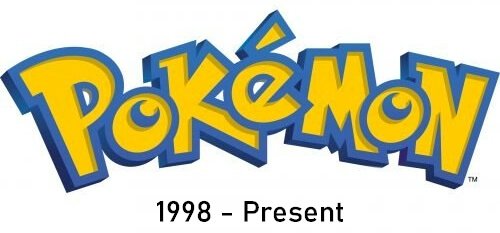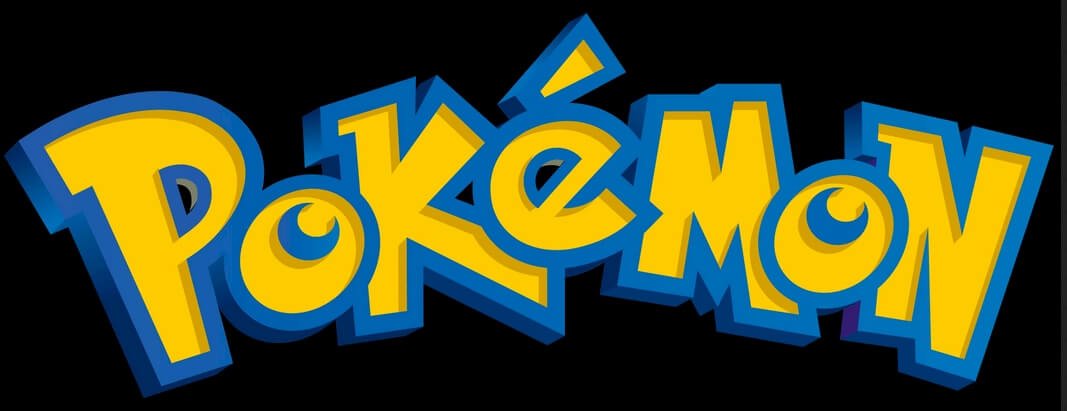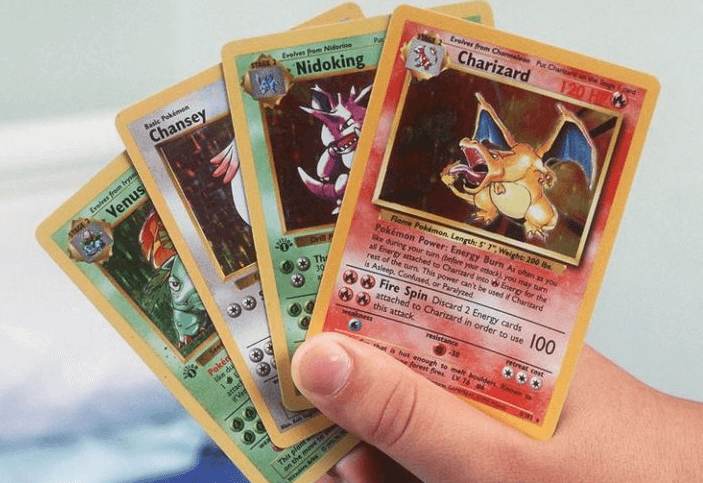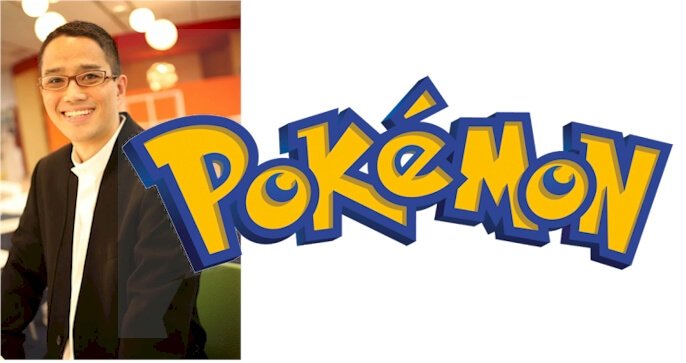This is a look at the Pokémon Logo and the History of the Game
The Pokémon media franchise boasts a noticeable inscription logo rendered in yellow and blue. The English version of the logo is arguably the most popular worldwide, but it isn’t the only version. The Japanese version of the inscription looks different and has a different theme but still retains its playful characteristic.
Pokémon is a renowned video game franchise owned and released by Nintendo Corporation. It was developed in 1996 by Satoshi Tajiri, a renowned Japanese video game developer. It’s estimated that sales of the franchise’s products, including toys, books, trading cards, anime, and comics, have gone past the $1 billion mark.
History of the Pokémon Logo
The evolution of the Pokémon logo
The Pokémon logo is an eye-catching yellow and blue logo. Most of us know its English variant, but it’s been translated into several other languages. All Pokémon logo variants look the same. Only the Japanese logo version is left out of the entire series as it’s different both in color and form. Nintendo owns the rights and trademark to both logos.
Satoshi Tajiri launched the Pokémon project in 1995. Still, it managed to become popular within a fairly short period, thanks to the original depiction of the fictional universe primarily aimed at children. Considering the target audience, there are some aspects of visual identification. In fact, the younger fan base pays attention to unique visual images and bright colors, making the logo stand out conspicuously.
Why the Pokémon Logo Has Never Evolved
The Pokémon media franchise has been in existence for 25 years now, with the franchise being launched by the Game Boy’s Pokémon Blue Version and Pokémon Red Version. The game series sees human trainers attempting to catch beings known as Pokémon and teaching them to fight each other.
The basic but addictive idea soon flourished into an expansive transmedia franchise that’s still going strong today. The franchise gave rise to a famous anime series, comics, toys, animated features, and plenty more.
The Pokémon franchise is getting a live-action film version as well, known as Pokémon: Detective Pikachu, in which Deadpool’s Ryan Ronald voices the character of the title. If the film becomes a hit, spinoffs and sequels will already be in the works.
The gaming division of the Pokémon franchise is still blossoming, with Nintendo Switch games Pokémon: Let’s Go, Eevee! And Pokémon: Let’s Go, Pikachu fast becoming some of Pokémon’s best-selling titles. If you’re a long-time Pokémon fan, you may have noticed that the colorful wordmark logo has never been changed or refreshed, save for some superficial alterations.
Where other best-selling video game series like Call of Duty or Resident Evil has changed recognizable emblems to mark a change in direction or tone, the Pokémon emblem has remained pretty much the same—even 25 years after the franchise started. Fans have become so used to it that they’re even making fun of it, so why has the logo never changed?
The answer appears to be in the approach Game Freak takes in developing the Pokémon series. While certain elements are upgraded or get more complex, the fundamental gameplay and elements remain the same. According to Pokémon director and producer Junichi Masuda, Pokémon is like basketball or soccer, where fans watch the action expecting a specific formula each time.
That’s why there’s never been a sweeping change in gameplay, and ostensibly why the Pokémon emblem has remained basically the same. The emblem also conjures up a certain nostalgia and warmth in fans today, and while they could joke about it, they’d probably not be too pleased if the iconic font ever got a makeover.
The franchise will go through a dramatic shift in direction and style someday, so in the meantime, followers of the franchise should appreciate the fact that the franchise is staying true to its tradition.
Pokémon Logo in Pop Culture
The Pokémon logo and franchise are connected with many different media. In general, the Pokémon characters have already become pop culture icons. Movies and newspapers always mention them; they’re part of parks, they feature on magazine covers, and so on.
According to psychologists, Pokémon is a pop culture icon because the video game creates a strong fictional universe and lets fans assert their personality. Kids pick a character that’s quite like their own personality and in that way affirm their likes and dislikes, differentiating themselves from their mates.
The Pokémon Logo Design Elements

Pokémon Symbol: The Pokémon emblem is technically an inscription, but in reality, the funny-looking letters are a much more recognizable feature of the series. The most popular characters can vary a great deal based on who created them, but they usually include Misty, Pikachu, Charizard Mewtwo, Mew, Ash, Arceus, May, Red, and Brock.
Pokémon Font: The word “Pokémon” comes from the original Japanese label “Pocket Monsters.” The Pokémon logo font is made up of a very energetic and playful inscription that is specially designed to attract kids. The Pokémon emblem is one of the most instantly recognizable and popular in toy and cartoon industries. It’s written in huge yellow letters with a blue outline, while the franchise name curves like a rainbow.
Pokémon Logo Colors: The yellow characters in the Pokémon emblem depicts optimism and joy, while blue represents class and excellence.
The History of Pokémon
 Pokémon is a video game franchise from Nintendo that was launched in February 1996 as Pokémon Red and Pokémon Green. The series later became very popular in the U.S. and all over the world. Originally designed for Nintendo’s Game Boy range of handheld consoles, Pokémon was introduced to the U.S. in 1998 with two titles dubbed Blue and Red.
Pokémon is a video game franchise from Nintendo that was launched in February 1996 as Pokémon Red and Pokémon Green. The series later became very popular in the U.S. and all over the world. Originally designed for Nintendo’s Game Boy range of handheld consoles, Pokémon was introduced to the U.S. in 1998 with two titles dubbed Blue and Red.
In the Pokémon series, players play as Pokémon trainers where they get cartoon monsters and develop them to fight other Pokémons. The game turned into one of the most popular video game series on the planet, second only to Super Mario Bros from Nintendo.
Pokémon Origins
Pokémon started as Satoshi Tajiri’s hobby. Tajiri enjoyed catching tadpoles and insects around a pond close to his suburban home in Tokyo as a kid. With the assistance of Ken Sugimori and others, Tajiri came up with Game Freak to give kids the same buzz of imagination he had as a child.
Tajiri was also greatly influenced by a TV show known as Ultra Seven, in which Ultraman would call upon giant monsters inside capsules to help fight evil. As such, it was originally named Capsule Monsters, although Tajiri failed in his first few proposals to Nintendo.
Later, with Shigeru Miyamoto’s help, Nintendo agreed to finance the project, although they still really didn’t understand it. They gave the partners 6 years to come up with the first game. But due to trademark concerns, Capsule Monsters became Pocket Monsters, giving birth to Pokémon.
The Start of Game Freak and Pokémon
Satoshi Tajiri designed Pokémon with the help of his illustrator friend Ken Sugimori.
Back in 1982, Tajiri teamed up with his friends to launch a gaming magazine named Game Freak. However, after some time, Tajiri decided to start developing his own video games rather than writing about them.
Seven years later, Game Freak became a gaming firm, and Tajiri and his friends introduced a few games like Yoshi, Mario and Wario, and Pulseman, which were received quite well.
In the beginning of the 1990s, inspired by his upbringing of exploring forests and collecting tadpoles and insects, Tajiri developed the Pocket Monsters idea (more popularly known as Pokémon) and put it forward to Nintendo.
The First Pokémon Titles Are Introduced
At first, Nintendo was not quite convinced by Pocket Monsters. Still, it eventually accepted the idea, and Tajiri spent the subsequent six years working with renowned video game developer Shigeru Miyamoto (who came up with The Legend of Zelda and Mario) to realize the dream of Pocket Monsters.
In February 1996, a green-red version of Pocket Monsters was published for the Game Boy range of handheld consoles in Japan. A cartridge housed the games, and players could exchange Pokémon via a cable connected to one another’s Game Boy.
Millions of copies of the games were sold, and they were later introduced to the United States in 1998. A year later, the games were introduced to the UK as a blue and red version (rather than green). The Pocket Monsters name was also abbreviated to Pokémon.
Seven extra generations of Pokémon titles have been released since then, from Silver and Gold to Sapphire and Ruby, Pearl and Diamond, Black and White, Sun and Moon, X and Y, and the latest title Sword and Shield.
Each new generation contained additional Pokémon titles. In fact, the Pokémon series now boasts about 898 different titles! So, it’ll take you quite some time to catch them all!
The Start of Pokémon Trading Cards

Following the success of Pokémon’s first few games, a company known as Media Factory came up with Pokémon Trading Cards (TGC). The first bunch of cards was introduced in October 1996, featuring 102 cards, with illustrations by Ken Sugimori, Keiji Kinebuchi, and Mitsuhiro Arita.
The cards quickly became wildly popular, and in 1999, they were brought to North America and the world over shortly after.
Pokémon card tournaments emerged, where players could take on each other, and now there’s even a global championship event.
Since then, over 30 billion Pokémon trading cards have been made, and some folks will even splash out several hundred thousand dollars for the rarest of cards.
The Launch of a Pokémon Television Series
In 1997, Pokémon inspired the launch of an animated television series in Japan. The series revolved around the life of a boy called Satoshi (named after the Pokémon inventor Satoshi Tajiri) as he embarked on a quest to become a Pokémon Guru with his mate Pikachu.
The TV series was released the world over, and Ash Ketchum became the new name of Satoshi Tajiri. Since then, the Pokémon TV series has had 23 series and over 1,000 episodes.
In 2019, Ash eventually won the Alola League and became a Pokémon Guru in the series named Sun and Moon.
The First Pokémon Movie
In 1998, a movie hit Japan’s cinemas. The film, named Pokémon: Mewtwo Strikes Back, revolved around trainer Ash Ketchum, who, along with his friends, is invited to a secret island where they come across the all-powerful Pokémon Mewtwo.
Pokémon: Mewtwo Strikes Back was a box office hit and released worldwide in 1999.
Since then, there have been 23 animated movies and a live-action film named Detective Pikachu, starring Ryan Reynalds.
Pokémon Goes Mobile
A pretty huge game was introduced to smartphones in 2016, making waves worldwide on its release. The game is known as Pokémon GO.
Pokémon GO was quite revolutionary. It let players explore their locality in real life, using augmented reality technology and satellite to make it appear like the Pokémon in their phone was actually there.
Upon its release, Pokémon GO broke download records, and since then, it has been download over 1 billion times! Now those are plenty of Pokémon trainers!
Pokémon’s Remakes and Future
In 2018, Nintendo introduced remakes of the Pokémon Yellow and Red and Blue games in the shape of Pikachu and Let’s Go Eevee.
New technology-enabled players to throw Pokeballs using Nintendo switch controllers. And with the help of a specially designed Pokeball controller, players could even take Pokeballs out for walks.
Pokémon shattered records within the first week of its release, sparking a new wave of remakes, including the recently released Pokémon Snap. The Pokémon Company plans to release more remakes in the future, so fans should look forward to them!
Final Thoughts
Very few video games have been quite as successful as Pokémon. First launched in February 1996 in Japan by Nintendo and Game Freak, Pokémon became a smash hit almost instantly.
Pokémon celebrated its 20th anniversary in 2016 by releasing Pokémon GO. The game became a smash hit over the summer of 2016 and, by November of the same year, Pokémon introduced Sun and Moon. So, it’s safe to conclude that Pokémon is still a very relevant player in today’s video game industry.
Many adults and young people enjoyed playing Pokémon in their childhood, so it can be argued that the games also create lots of nostalgia. Overall, Pokémon has sold more than 279 million games worldwide, according to Kotaku, a gaming website. And according to a 2014 article in the Nintendo News, The Pokémon Company rakes in $1.5 billion per year making Pokémon and the Pokémon logo world famous.







